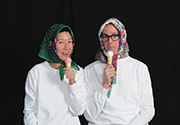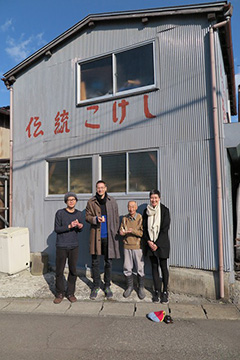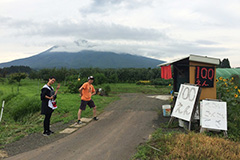PHASE 2015 Japanese COMPANY: SECRETS OF NORTHERN JAPAN
In 2014, the Aomori Museum of Art launched a project called “PHASE” (pronounced ˈfaːzə), in which we invite talented young artists from Japan and abroad to realize the maximum potential of the museum as an exhibition space. The word “phase” is taken from German and refers to a “phase” or an “aspect.” The project aims to drive participating artists to their next “phase” in a certain place within the Aomori Museum of Art that generates many “aspects”.
In 2014 and 2015, we welcome artist and Aomori native Yoshitomo Nara as director of PHASE to Hakkakudo, an octagonal space designed by Nara at the Aomori Museum of Art and the site of PHASE for these first two years. PHASE director Nara has invited Johan Olin from Finland and Korea-born Aamu Song, who comprise the two-person unit COMPANY, from their home in Helsinki to participate as artists in PHASE 2015.
In recent years, COMPANY has devised a series entitled Secret, in which longstanding traditional crafts are reborn as brand-new products. With each installment, COMPANY incorporates their own original, playful aesthetic into product design while retaining the beauty and technique of traditional crafts rooted in places like Finland, Belgium, Korea, and Russia. They now visit Aomori and Japan’s northern region in their next Secret project to explore its various traditional crafts, which are borne of wisdom needed for life in the north’s harsh natural environment.
The central concept of SECRETS OF NORTHERN JAPAN revolves around the spirit of products. COMPANY states, “Every product has their own spirit.” Kindled by the spirituality that dwells within everything from northland’s handmade traditional crafts to mass-manufactured everyday goods, they intend on accomplishing new value creation through product design.
PHASE2015 website
COMPANY
Design duo established in 2000 by Finland-born Johan OLIN and Korean Aamu SONG.
Their activities extend beyond Finland’s borders to numerous large-scale exhibitions that include the 2011 London Design Festival and the 2008 Milan Furniture Fair. Since 2007, COMPANY has developed their Secret product series, which is inspired by traditional crafts from countries such as Finland, Russia, and Korea. In 2010, they were awarded the State Prize for Design by the Art Council of Finland. COMPANY also runs Salakauppa, a shop in central Helsinki where they sell their original designs and products.

Message from COMPANY
In summer 2014 and winter 2015, COMPANY toured northern Japan and met with masters of old, local techniques.
We already knew Japan as the country of handcraft and tradition.
But there was one thing we found out this time.
The spirit.
We learned from Ozorezan on the Shimokita Peninsula, from the Kawakura Sai-No-Kawara Jizoson (Jizo hall) in central Tsugaru, from the works of kokeshi masters that belief can be visually expressive, beautifully sad and melted into the normal life.
This time we not only design new items based on traditional techniques but create the spirit of each product.
Each spirit is created based on COMPANY’s belief that a good product has good spirit.
On the opening evening of the exhibition, the spirits will march into the products.
All items in the ‘Secrets of Northern Japan’ collection are designed by COMPANY and inspired by northern Japanese tradition, craft and belief.
While most products are crafted by Japanese masters and local industries, some are also made by Finnish handcraft masters.
Inside the Aomori Art Museum, COMPANY shows previous works from our ’Secrets of Finland’ and ’Secrets of Russia’ projects. There is a strong connection between the northern traditions reaching from Finland through northern Russia all the way to Japan.

Message from Yoshitomo Nara
…Secrets of COMPANY
Last summer, I traveled around Aomori’s Tsugaru region with COMPANY, a design duo from Finland. They had already done most of their research on Tohoku for this exhibition, and Aomori was their final destination. We strolled around Hirosaki, visiting neputa garages and traditional lacquerware studios. We even tried our hand at bunako (1) and Japanese dyeing techniques, heard a live Tsugaru shamisen performance, and enjoyed the impressive entertainment of Aomori Nebuta Festival and the summer fireworks. I initially intended to show them the typical tourist side of Aomori but found myself having just as much fun in the process.
COMPANY never missed a chance to jot down notes in a small notebook that they took with them wherever we went. The pages of their notebook were filled with handwritten figures and diagrams drawn during visits with kokeshi masters and other craftsmen from throughout the Tohoku region. Their notes reminded me of the records of Europeans on their first travels to the remote corners of 19th century Japan. Seeing these caused me to lose track of when and where I was. When I start to think about how ordinary landscapes, even the many apple orchards that locals like me take for granted, probably appear as vibrant landscapes in their eyes, I remember that it has now been more than 30 years since I left my birthplace. And suddenly the scenery comes alive and looks more vivid than ever before.
On the final day of our travels together, we found a place to stay at the foot of Mt. Iwaki, a mountain that has long been a center of nature worship, and proceeded to climb its summit and explore the surrounding forests. I think that it was during this day that COMPANY was able to transcend differences in culture and custom to make a spiritual connection with Tohoku’s northern periphery, which may not be surprising given Finns’ traditional penchant for living in harmony with nature. As we left Mt. Iwaki behind, I suddenly thought of taking them to Kawakura Sai-no-Kawara Jizoson, a spiritual spot in Goshogawara well off the beaten tourist path. This would prove to be an important step in the formation of ideas for this exhibition.
They told me that they had already visited Osorezan, but the experiences at Kawakura Sai-no-Kawara Jizoson must have had quite the impact. Dolled-up stone jizō statues await visitors inside the main hall, full of expressive and artistic intrigue. But it was the moment we entered the adjacent hall that we went speechless. Sets of fūfu ningyō, or “married dolls,” lined the walls; there had to be at least 2,000 dolls in all. Parents and relatives who have lost a child will enshrine these dolls around the time that child would have approached a suitable age for marriage. The use of dolls in these “ghost weddings” is a relatively recent tradition, said to have started after the end of World War II. Even to me, it seemed like a strange custom confined to the northernmost edge of Honshu. I couldn’t help but realize the peculiar nature of the place where I was born and raised as I explained the fūfu ningyō and mizuko jizō, the guardian of stillborn and aborted fetuses, to COMPANY in my stilted English.
Historically, the people of Finland practiced Scandinavian nature worship, a polytheistic tradition that believed deities could be found within everything. This continued until the advent of Christianity and modernization. Today we still see a spiritual connection to forests and nature in the lives of the Finns, where superstitions still persist. To me, this resembles the traditions of Aomori. Many people still flock to Osorezan or Kawakura to listen to itako, female shamans who serve as mediums between the worlds of the living and the deceased. Or, take for example, the custom of women playing with oshirasama dolls in a room that men are not allowed to enter (2). Those who practice these traditions in Aomori today are of course in the minority. They are often seen as objects in need of preservation and may only remain as a facet of tourism. However, their existence attests to the fact that we retain spiritual perceptions in our modern lives.
Although the COMPANY twosome is based in Finland, one member of the duo is Korean. Aamu Song is originally from South Korea but studied abroad in Finland, choosing to stay with her Finnish counterpart, Johan Olin, after graduation. South Korea is another country where magic and shamanism have survived and are still present in people’s daily lives. Judging from her manner of speech and ambience, I feel that Aamu is able to consciously harness this spiritual inspiration. I digress, but her sensitivity closely resembles the feeling I get from the singer Björk, whose native Icelandic culture still retains elements of nature worship. I would not be surprised in the least if COMPANY showed interest in the indigenous spirituality they saw on their travels through Tohoku.
As I write this message, I don’t know much about the details of their exhibition yet. But I’m sure that it will go beyond “cool” and will buck the recent trend to simply “go local.” Whatever COMPANY has picked up in their travels across the Tohoku region is sure to connect back to the peculiar magnetism of Tohoku—and Aomori in particular—a place to which I am forever bound by my background.
Finally, I would like to mention my first encounters with COMPANY. We first met in 2006, neither in Finland nor Japan but in distant Bangkok. We were introduced by a mutual friend at a group exhibition held at a gallery in Silpakorn University where we were all participating artists (3). At the time, I had a great interest in their work but didn’t have the opportunity to talk much with them, and we never did keep in touch.
Six years later, in 2012, I took my first trip to Finland to give a lecture at a Helsinki art museum. As I wandered the morning streets, a man preparing to open his small boutique called out to me: “Nara-san?” It had been seven years since I had seen Johan and Aamu last. Inside their shop, I experienced the products firsthand and listen to their explanations. They told me their products were all based on the local cultures of places they had visited, the result of collaborations with skilled craftsmen and their own original ideas. Each brimmed with creativity. And by coincidence, their exhibition on Russia was currently showing at the museum where I gave my lecture (4). Their project with Russian artisans was entirely fascinating! From that moment on, I began to think that our reunion was inevitable and made up my mind to invite them to Aomori, which has led us to this exhibition today.
I didn’t mention their past works or projects, so please visit their website and see for yourself (5). Trust me, you’ll enjoy it!
(1) A type of local woodcraft using beech wood (buna in Japanese) native to Aomori. Wood is sliced into one-millimeter ribbon-like strips and coiled around to make bowls, dishes, and other receptacles. Produced in Hirosaki by BUNACO Co., Ltd., which has a fifty-year history in the craft.
(2) Blind and nearly blind female shamans called itako gather yearly at the annual festivals of Osorezan (July 20-24), one of Japan’s three most sacred spots, and Kawakura-Sai-no-Kawara-Jizoson (June 22-24 on the old Japanese calendar). As per clients’ requests, itako perform kuchiyose, a process of summoning the dead from the great beyond.
Oshirasama are celebrated as guardian, tutelary deities in Tohoku households and are also commonly viewed as the gods of silkworm production. But in Aomori, they have long been believed not only to be protectors of the home but also the gods of agriculture and fire prevention and are said to be able to ward off evil spirits. Their wooden bodies are whittled to around 30 centimeters in length in the form of a male-female (or horse-female) pair. Worshipped by women, oshirasama wear several layers of rags called osendaku. Female folk shamans called itako or kamisama are called to the home to perform a rite called oshirasama-asobase. In some places, housewives from an entire village will come together for annual observances of oshirasama-asobase.
(3) 2006 Temporary Art Museum Soi Sabai Exhibition at Silpakorn University in Bangkok, Thailand.
(4) In 2012, a work from COMPANY’s “Secrets of Russia” was on display in the group exhibition Camouflage at Kiasma, a contemporary art museum in Helsinki.
(5) COMPANY website (English): http://www.com-pa-ny.com

Details
Period
August 1(Sat) — September 13 (Sun), 2015
Days Closed
August 24 (Mon)
Opening Hours
9:00-18:00 (Entrance until 17:30)
Location
Hakkakudo & B2 NARA Yoshitomo Exhibition Room at the Aomori Museum of Art
Admission
Free access to the Hakkakudo | Permanent Exhibition Ticket to see B2 NARA Yoshitomo Exhibition Room
Supported by
Embassy of Finland, Tokyo
Special Support and Grants from
The Ministry of Education and Culture, Finland | The Finnish Institute in Japan
Grants from
Finnish Cultural Foundation
Sponsored by
EPSON

